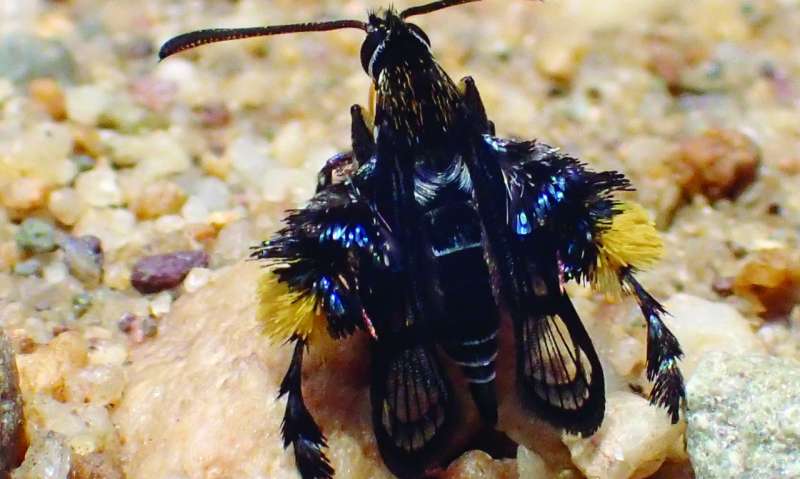May 2, 2018 report
Clearwing moths found to fly like bees to enhance deception (Update)

A team of researchers with members from Poland, Australia and the U.S. has found that some types of clearwing moths fly like bees to avoid predators. In their paper published in the journal Biology Letters, the group describes their study of the insects in Southeast Asian rainforests and what they found.
Clearwing moths get their name from the transparency of their wings. This physical characteristic is just part of the disguise—the moths also have other features that resemble bees or wasps. Prior research has shown that the reason the moths have evolved to look like bees or wasps is to fool predators. Birds, for example, do not like getting stung any more than we do. But the researchers with this new effort wondered if the clearwings attempt to imitate bees and wasps in others ways. Most particularly, they wanted to know if the moths mimicked bee flight behavior. Anyone who has seen moths can attest that they tend to flutter about, like butterflies. Bees, on the other hand, tend to hover and dart from place to place. Clearwings, the researchers note, forage during the day, which means they are more likely to be targeted by predators that use sight to capture prey (as opposed to night predators such as bats, which use echolocation). They further note that it is likely that foraging during daylight hours played a strong role in clearwings developing bee and wasp-like characteristics.
To learn more about clearwing behavior, the researchers traveled to several jungles in Southeast Asia, where many species of the moths live. They set up high-speed cameras and recorded the flight action of four clearwing species and then studied them later to note their flight behavior. They report that three of the bee-looking species flew in patterns clearly reminiscent of bees—the fourth looked and flew much like a wasp. The researchers noted that the clearwings that flew like bees resembled a dwarf honey bee and a type of bee that does not sting—instead it bites, which is another way to ward off predators. The researchers noted that none of the clearwings were perfect mimics but were convincing enough to fool predators, especially when they were flying.
More information: Marta A. Skowron Volponi et al. Moving like a model: mimicry of hymenopteran flight trajectories by clearwing moths of Southeast Asian rainforests, Biology Letters (2018). DOI: 10.1098/rsbl.2018.0152
Abstract
Clearwing moths are known for their physical resemblance to hymenopterans, but the extent of their behavioural mimicry is unknown. We describe zigzag flights of sesiid bee mimics that are nearly indistinguishable from those of sympatric bees, whereas sesiid wasp mimics display faster, straighter flights more akin to those of wasps. In particular, the flight of the sesiids Heterosphecia pahangensis, Aschistophleps argentifasciata and Pyrophleps cruentata resembles both Tetragonilla collina and T. atripes stingless bees and, to a lesser extent, dwarf honeybees Apis andreniformis, whereas the sesiid Pyrophleps sp. resembles Tachysphex sp. wasps. These findings represent the first experimental evidence for behavioural mimicry in clearwing moths.
Journal information: Biology Letters
© 2018 Phys.org





















